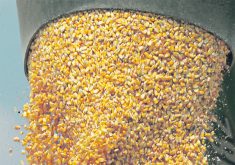Evidence is mounting that India is in line for a larger than normal shortfall in its summer pulse harvest, yet importers have been reluctant to buy product from Canada to fill the looming void.
A Canadian market analyst said India’s government has implemented policies that are causing temporary market confusion, but it’s only a matter of time before the country turns to Canada for yellow peas.
“I think it’s going to come. It’s just stalled,” said Greg Kostal, president of Kostal Ag Consulting.
Read Also

Methane tractor debuts at Agritechnica 2025
New Holland has unveiled its production-ready version of a T7.270 methane-powered tractor at the Agritechnica farm machinery show in Hanover, Germany.
With each passing month it is becoming more apparent that India’s kharif or summer crop is in trouble.
Farmers seeded 25 million acres of pulses as of Oct. 15, which was 5.6 percent above last year’s kharif plantings but 9.3 percent below the long-term average.
Rainfall during the critical monsoon season, which lasts from the beginning of June to the end of September, was 23 percent below the 50 year average, according to the India Meteorological Department’s end-of-season report on the 2009 monsoon.
The agency reports that 59 percent of the country’s 526 meteorological districts received “deficient” or “scanty” rainfall during the monsoon season. Many of the districts were in the central and northern parts of the country where most pulses are grown.
The dismal monsoon season has contributed to food price inflation in India. Pulse prices are up 20.5 percent over the same time last year.
India’s minster of state for agriculture said the country will have to make up for a deficit of four million tonnes of pulses this year.
Earlier this summer, the U.S. Department of Agriculture was forecasting 2.4 million tonnes of pulse imports in 2009-10, up from 2.2 million tonnes in 2008-09.
Kostal doubts India will import four million tonnes because the pulse deficit in the country is usually two to three million tonnes, about half of which will be covered by imported yellow peas.
However, there hasn’t been much action so far. Bulk pea exports from Canada were 302,300 tonnes as of Oct. 11, which is 31 percent below last year’s pace.
Kostal said that’s because the Indian government recently changed inventory ownership rules to circumvent hording.
“They’re going into warehouses and saying, ‘you can only have so much tonnage,’ ” he said.
Penalties for hording pulses are severe enough that it has pushed an estimated 500,000 tonnes of peas onto the market.
“That’s got to work its way through,” Kostal said.
The government’s actions are suppressing and confusing international pulse markets.
“It just kind of keeps things more orderly, more ho-hum. They have control,” he said.
“We’re essentially at a stalemate.”
Canadian spot yellow pea prices for the week ending Oct. 16 averaged $4.85 per bushel, according to Stat Publishing’s daily survey of buyers, which is less than half the value of last year’s highs.
Kostal said demand will come but it may not be until the new year. India bought 1.34 million tonnes of bulk peas from Canada in 2008-09.
He expects another 1.25 million tonnes will be shipped this crop year.
New year shipments
Product may not start moving in earnest until the new year, which will put further strain on the grain handling and transportation system. The shipping window will likely last until April when India’s rabi or winter harvest begins.
While most parts of India haven’t received adequate moisture this growing season, some have received too much.
Flooding has damaged up to 80 percent of the tur dal, or pigeon pea, crop in Karnataka, according to Business Standard, one of India’s leading business publications. The state typically produces about 12 percent of India’s pigeon pea crop.
There are reports that tur dal prices have risen 50 percent over the last four months. Kostal said split green lentils are used as a substitute for pigeon peas, so that is supporting green lentil prices in Canada, which are up slightly from a month ago.















